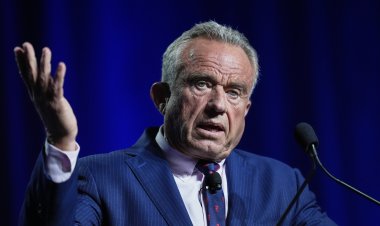JD Vance Cites Rising Home Prices as a New Reason to Criticize Illegal 'Immigrants'
It presents a compelling argument ahead of the election, as it combines two significant issues that voters are facing: skyrocketing housing costs and a surge in undocumented immigration.

“You’ve got housing that is totally unaffordable because we brought in millions of illegal immigrants to compete with Americans for scarce homes,” he asserted during the vice presidential debate.
Although Vance's argument may be overstated, there is some truth to it.
Research indicates that immigrants contribute to increased housing demand, which intensifies supply shortages and raises prices. However, there are larger factors contributing to the current affordability crisis, notably the historically low construction rates following the 2008 financial crisis.
Before the upcoming election, Vance's argument holds significant weight as it combines two major issues that concern American voters: soaring housing costs and the influx of undocumented immigrants in recent years.
Jason Furman, a former top economic adviser to President Barack Obama, remarked, “If you don’t like immigration you make any argument against it you can. In the past it was, ‘They’re going to bring down the value of your home,’ even though there wasn’t a lot of evidence to support that. Now the problem is, ‘They’re driving up the value of the home you want to buy, so they’re bad.’”
He also pointed out, “Immigrants do actually drive up the value of houses, but it’s also the case that it only explains a small fraction of the increase we’ve seen in recent years. JD Vance is getting the sign right and the magnitude wrong.”
Vance is not the only politician identifying immigration as a significant factor in the nearly 50 percent rise in home prices over the past four and a half years. Former President Donald Trump and GOP lawmakers, including Rep. Glenn Grothman from Wisconsin, have echoed similar sentiments, with Trump promising to prohibit undocumented immigrants from acquiring mortgages. Some Federal Reserve officials have linked immigrant demand to rising prices, and while Fed Chair Jerome Powell downplayed this connection at a July hearing, he acknowledged potential regional impacts.
The basic premise that increased demand exacerbates supply shortages is logical, yet the link between immigration and surging prices is not straightforward.
Chris Herbert, managing director of Harvard’s Joint Center for Housing Studies, stated, “While immigrants do add to overall housing demand, they cannot be blamed for the recent surge in home prices and rents that took off in 2020 and 2021, as immigration reached its lowest levels in decades due to the pandemic.” He further noted, “Immigration started to surge in 2022 and peaked in 2023, even as growth in home prices and rents slowed dramatically. Trends in interest rates and the pandemic-induced demand for housing were mostly responsible for the recent trends in housing costs.”
Additionally, most recent immigrants are renters rather than homebuyers. According to a Center for Immigration Studies analysis, 89.5 percent of households headed by an immigrant who arrived in the past two years reported being renters.
“These undocumented immigrants are not the people who are buying homes,” asserted Daryl Fairweather, Chief Economist at Redfin. “You need a lender to lend you money, you need documentation, you need credit checks to buy a home … Perhaps you could argue that they have an impact on the rental market, but they are more likely to live in overcrowded housing, to seek out family members who already have a home and double up.”
Moreover, the process of immigrants forming new households takes time, leading to a delayed impact on housing demand, according to Lu Chen, Senior Economist at Moody’s. Chen and colleagues recently published an analysis highlighting that “in terms of housing demand, immigrants, particularly newcomers, make up a significant portion of renter households. A considerable reduction in this population could greatly reduce housing demand, predominantly impacting the multifamily market and putting downward pressure on rent.”
As of 2022, approximately 11 million unauthorized immigrants were living in the U.S., as per a Pew Research Center analysis of Census Bureau data, a number that has since increased. Vance claimed on Tuesday that “25 million illegal aliens” were contending for homes, while Trump vowed to deport them.
This rise in the immigrant population comes alongside a significant shortfall in new home construction over the past two decades, which, according to a 2021 report from the National Association of Realtors, fell short of typical levels by 5.5 million to 6.8 million units. Recovery to 2006 construction levels only occurred in 2021.
Steven Camarota, Research Director at CIS, testified before the House Oversight Committee last week that 2.4 million new immigrant-headed households have emerged since January 2021, “with perhaps 1.4 million of this increase due to illegal immigration.”
When Vance was challenged by Gov. Tim Walz and the debate moderators for economic evidence supporting his claims on Tuesday, he referenced a “Federal Reserve study.” Later that night, he pointed out a May speech by Fed Governor Michelle Bowman.
“Given the current low inventory of affordable housing, the inflow of new immigrants to some geographic areas could result in upward pressure on rents, as additional housing supply may take time to materialize,” Bowman noted.
Minneapolis Fed President and CEO Neel Kashkari also remarked this year that “immigrants … need a place to live, and their arrival in the U.S. has likely also increased demand for housing.”
Research from MIT Professor Albert Saiz found that “an immigration inflow equal to 1 percent of a city’s population is associated with increases in average rents and housing values of about 1 percent” in a 2006 study. A recent working paper from the University of Texas at El Paso observed a more significant effect, indicating that a 1 percent increase in the immigrant share of a local population correlated with a 7 percent rise in home price appreciation.
However, Saiz added that immigration “is not even close to explaining 95 percent of what’s [been] going on” in rental markets over the last few years. “Assuming that three million additional immigrants arrived in the last three years, that’s less than one percent of the U.S. population. If you look at it distributed equally it could explain one percent of rental growth nationally, not the 20 percent we’ve seen.”
Additionally, immigrants play a crucial role in the construction industry, which is already facing significant labor shortages. The most recent American Community Survey from 2022 indicates that one in four construction workers is an immigrant. This proportion is even higher in specific construction trades, where immigrants account for 31 percent of the workforce.
“When economists talk about housing policy, they’re really talking about building enough supply to meet demand,” stated Fairweather from Redfin. “I've just never encountered controlling population growth as a policy for making housing affordable. It’s pretty out there — it would cause a whole host of problems that have nothing to do with housing.”
Thomas Evans for TROIB News
Find more stories on Business, Economy and Finance in TROIB business












